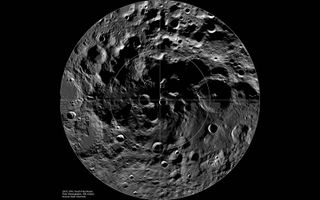- UID
- 20
- Online time
- Hours
- Posts
- Reg time
- 24-8-2017
- Last login
- 1-1-1970
|
|
━━━━━━━━━━━━━━━━━
Its surface could preserve the remains of organisms or even technology from beyond our solar system.

The cratered south pole of the moon can be seen in this image taken by NASA's Lunar Reconnaissance Orbiter.(Image: © taken by NASA's Lunar Reconnaissance Orbiter)
▼ NASA recently announced the Artemis lunar exploration program, consolidating its plans plans to land humans on the moon by 2024 and establish a sustainable base there by 2028. This ambitious initiative revives an old question: Will the unique qualities of the lunar surface enable new frontiers in astronomy?
A few decades ago, astronomers had already begun to contemplate different ways their observations could benefit from the absence of an atmosphere on the moon. First, energetic particles such as gamma rays, x-rays, ultraviolet photons or cosmic rays would not be blocked by an atmospheric blanket as they are on earth, and hence they would reach telescopes with large collecting areas mounted to the lunar surface. Second, observatories sensitive to optical, infrared, millimeter or radio waves could reach their diffraction limit without the blurring or absorption associated with passage through turbulent air. Arrays of detectors could therefore constitute giant interferometers with unprecedented angular resolution.
Third, the lack of an ionosphere would allow radio observatories to receive signals at very low frequencies, below the terrestrial cutoff of 10 kilohertz. This would open a new spectral window into the universe, allowing to map the three-dimensional distribution of hydrogen atoms from their first appearance 0.4 million year after the big bang and through the cosmic dawn, using the highly redshifted 21-centimeter line. Although exciting and path breaking in their own right, these visions were all formulated well before the emergence of the frontier of astrobiology associated with the search for extraterrestrial life.
Can the moon provide clues for extraterrestrial life? A new paperI wrote with Manasvi Lingam answers this question in the affirmative. The idea is to consider the moon's surface as a fishing net for interstellar objects collected over time and potentially deliver building blocks of life from the habitable environments around other stars.
The lack of a lunar atmosphere guarantees that these messengers would reach the lunar surface without burning up. In addition, the geological inactivity of the moon implies that the record deposited on its surface will be preserved and not mixed with the deep lunar interior. Serving as a natural mailbox, the lunar surface collected all impacting objects during the past few billions of years. Most of this "mail" comes from within the solar system.
But the solar system also intercepts objects from (▪ ▪ ▪)
► Please, continue reading this article here: Source |
|